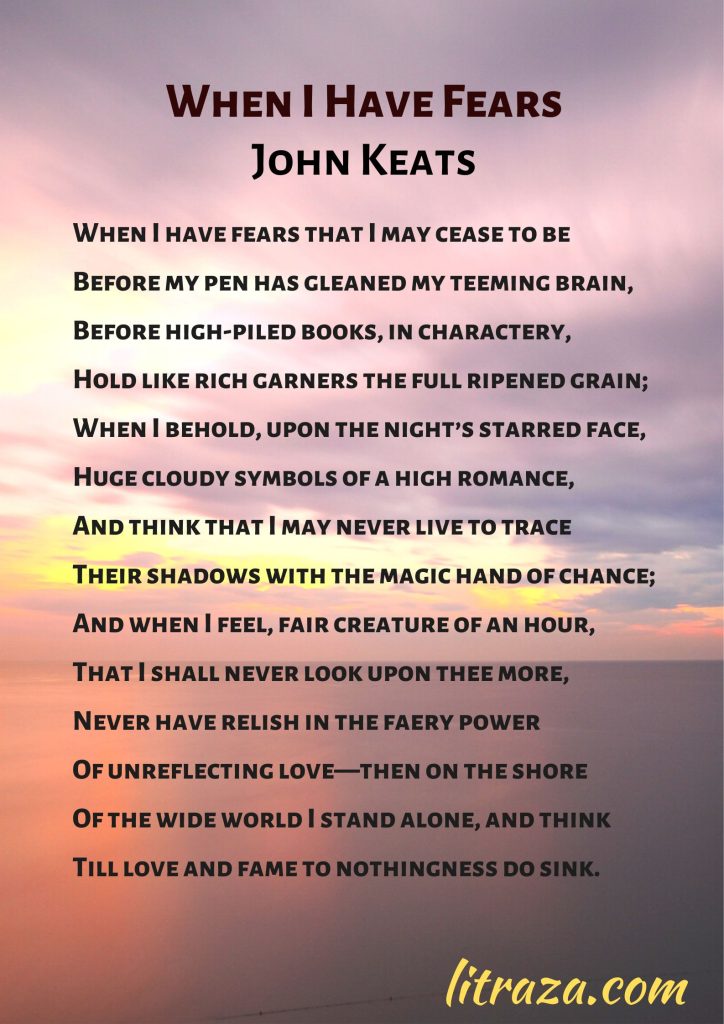When I Have Fears by John Keats is a lyric poem. The poet shares his extremely personal or intimate feelings in this poem. This poem is in the Shakespearean/Elizabethan sonnet tradition. Critics appreciate and admire this poem not only for poetic finesse but also for its subject matter. Keat was one of the most illustrious poets of the Romantic era. The lovers of poetry feel sorry for Keats’s death at a very young age. They believe that Keats, an accomplished and prolific poet, would have written much more if he had lived longer. When I Have Fears by John Keats deals with the poet’s apprehensions about his early demise. Since the same happened, the poem attracted the special attention of Keats’s admirers. This article, When I Have Fears by John Keats – Summary Analysis Questions, elaborates on various aspects of the poem. It will improve your comprehension of the poem.
A Brief Biography of John Keats
Synopsis of Life
I find it hard to say ‘Keats’s early life’ because Keats died at an age when people just begin to live. The most renowned of the second-generation Romantic poets, John Keats, was born in London on October 31, 1795. Of four siblings, he was the eldest. His father, a livery stable manager, died in 1804. His mother remarried straight away. Her marriage did not last long and she also faced financial setbacks. However, after her divorce, she chose to live with another man. Keats had an unusual attachment to his siblings. In 1818, he met Fanny Brawne with whom he fell in love. In the same year, Keats had to attend to his brother who suffered from tuberculosis. Keats wrote When I Have Fears during the same period. It reflects the impact of his brother’s disease on his psyche. In 1820, Keats caught consumption. He died on February 23, 1821.
Interest in Literature
In 1803, a year before his father’s death, Keats joined a school at Enfield. Here, Keats befriended Charles Cowden Clark, the son of the headmaster, John Clark. Charles introduced him to literature. Under Charles’s mentorship, Keats read the Renaissance masters like Spencer, Tasso, and Chapman. Charles also introduced him to Leigh Hunt who paved way for his recognition in literary circles. As a poet, Keats’s early works did not get popular acclaim. However, the year 1819 proved very fortunate for him. It was during this year that he write all his known works. Keats is famous for the sensuousness of his poems.
Text of the Poem When I Have Fears by John Keats

Summary of the Poem When I Have Fears by John Keats
Introduction
When I Have Fears by John Keats resonates with the poet’s subjective thoughts about his fear of early death. It also dwells on his ambition to compose a large number of poems. Keats inherited tuberculosis as a genetic disease. At that time, this disease was incurable. Therefore, there is a sense of certainty associated with Keats’s fears. Keats, an ambitious poet, wants to achieve immortality through his poetic works. He wants his readers to remember him even after his death. Therefore, he desires to write poems in huge numbers. He believes his fame will keep him alive, though only in memory of his readers.
Keats’s Expression of His Fears
When I Have Fears by John Keats begins with the poet expressing the fright of his early death. He doubts whether he will be able to write poems on all the ideas he has in his mind. The poet wishes to write poems in such huge numbers that they should fill heaps of anthologies. Keats employs the metaphor of a farmer’s granary full of sacks of grains to express his ambition. Each sack represents an anthology wherein each grain is a poetic work. It reflects how much importance Keats attached to his poems. He wants them to be preserved like a vital necessity of life
Keats’s Reference to Natural Beauty
Keats shares another side of his fears. He looks at the night sky which is full of stars with patches of clouds here and there. Keats calls them romantic symbols. As a lover of nature, Keats wants to incorporate these symbols in his poetry. He wants to portray this scene in the minutest details with his poetic craft of words. However, for the fear of his death, he doubts whether he would be able to do so or not. Keats’s reference to the starry night sky is just an example. He aspires to write poetry on every aspect of natural beauty.
Keats’s Feelings for His Beloved
Keats thinks sorrowfully that after his death, he will not be able to see his beloved. He addresses her as the fair creature of the time. Love does not depend on reflections and deliberations. It just happens. Keats has the same unreflecting love for his beloved. This love revitalizes the poet with its ethereal power. He thinks that he will not enjoy her reinvigorating love after his death.
Keats’s Thoughts about Love and Fame
The poem ends with Keats relating the real aspect of his fears. He comments on the futility of love and fame in competition with death. He believes that with the death of a person, all the love and fame associated with him sinks to nothing. Keats wants his love to be remembered. He also wants his fame to last long. But with an awareness of fast-approaching death, the poet feels helpless. He feels as if he were standing at the shore of time and watching his love and fame sink to nothingness.
Conclusion
When I Have Fears by John Keats is based on fears and apprehensions that surrounded Keats all through his life. He was afraid of being forgotten as a poet. Indeed, he could not write as many poems as he wanted. But the time proved his fear of being forgotten a misconception on his part. Keats died in 1821. But his poems never let him fade away from the memory of his admirers.
Important Questions
Q1: Discuss When I Have Fears by John Keats as a sonnet.
Q2: What is the nature of Keats’s fears?
Introduction
John Keats wrote When I Have Fears in 1818. The poem, however, had its first publication in 1848, which makes almost twenty-seven years after his demise. It is notable that in 1818, Keats looked after his brother, Tom, who suffered from tuberculosis. His brother could not survive. Earlier in 1810, Keats’s mother also died of tuberculosis. These two deaths in such a short span shocked Keats. It was evident that the family had a medical history of tuberculosis. Keats feared that he might die the same way soon. This poem focuses on this fear of the poet.
Sonnet
A sonnet is a poem comprising fourteen lines composed in iambic pentameter. In Italian or Petrarchan structures, a sonnet has two parts. The first part comprising eight lines is called an octave. In this part, the poet presents a problem, puts a question, or shares the cause of anxiety. The second part of a sonnet that comprises six lines is called a sestet. In a sestet, the poet presents the solution to the problem, addresses the question, or suggests the remedy to relieve the anxiety.
When I Have Fears as a Sonnet
When I Have Fears by John Keats is a sonnet. In this sonnet, John Keats has followed what we call the Elizabethan or Shakespearean tradition of a sonnet. In this tradition, the sonnet comprises three quatrains and a couplet. The quatrains all together play the same role as an octave in a Petrarchan sonnet. The couplet contains the shift part, or the solution.
Line 1-4
In the first four lines, the poet expresses his fear of early death and desire to write countless poems. He employs the metaphor of a farmer’s harvest to present the keenness of his desire.
Line 5-8
In the next four lines, Keats makes a mention of the sky full of stars. Once again, he uses a metaphor, this time an extended one, of a magic hand to trace its beauty.
Line 9-12
In lines nine to twelve, the poet regrets that he will not be able to see his beloved after his death. He will not miss her ‘unreflecting love’.
Line 13-14
From the mid of line twelve, the shift begins. Keats, who has been aspiring for fame and love in earlier lines, comments on the futility of effort. He believes that all his fame and love are about to sink into the sea of nothingness. But he cannot do anything to retain these.
The Nature of Keats’s Fears
Keats was not as afraid of death as he was of the loss of love and fame. He was also afraid of his talent for poetry going to waste if he died soon. The poet wanted to have some magical powers wherewith he could force his pen to glean all his thoughts. He wished not to be forgotten. He wanted his poetry to be an as essential part of world literature as grain for the human diet. It may also imply that he wanted his poetry to be food for thought. Keats’s fears also include the sense of loneliness associated with death. He feared that he would not enjoy the love of his beloved after death. What heightened his fears so much was the sense of helplessness in front of the decree of fate. He had no control over the circumstances. This lack of control creates despondency and despair in Keats.
Conclusion
When I Have Fears by John Keats is an admirable lyric poem. The diction of the poem well suits the theme and nature of the poem. The sensuousness associated with Ketsian depiction is a hallmark of this poem as well. The concluding couplet also fulfils the expectation of the readers who seek negative capability in Keats’s poems. There is a sudden shift from ambitiousness to helplessness. The poem, doubtlessly, reflects Keats’s mastery of the art.
Also read: The Vanishing Village by R. S. Thomas – Summary Analysis Questions



